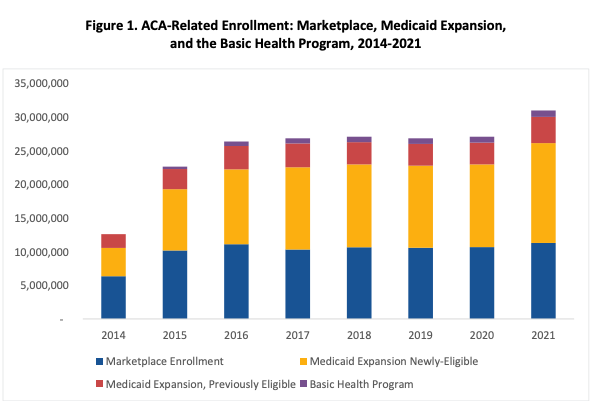More people than ever are getting health insurance through the Affordable Care Act, providing new proof of the law’s value even as its survival depends on a Supreme Court ruling that could come as soon as Monday.
Approximately 31 million people now get coverage through “Obamacare,” according to a report that the Department of Health and Human Services issued Saturday. In most cases, that means they’ve enrolled in newly expanded Medicaid programs or purchased subsidized insurance through HealthCare.gov or state exchanges like Covered California.
That figure is the highest ever and reflects a nearly 4 million-person increase in enrollment between 2020 and 2021, following four years when combined enrollment in the Affordable Care Act’s programs was basically flat.

The surge is not especially surprising, given how many people lost incomes or jobs during the pandemic. One of the Affordable Care Act’s primary purposes is to create a safety net, so that people can get insurance ― and pay for their medical care ― even if they don’t have access to employer-based insurance or can’t afford premiums.
Also, the program as a whole is under new management. During his term in office, President Donald Trump worked with Republicans in Congress to repeal the program. Although they failed, the administration slashed funding for outreach and promotion, reflecting Trump’s open hostility to the program.
Joe Biden, who famously called the Affordable Care Act “a big fucking deal” when President Barack Obama signed it in 2010, has taken a very different attitude. One of his first actions as president was to establish a new “open enrollment” period that, with an extension, will go through August.
No less important, he worked with Democratic leaders in Congress to enact a COVID-19 relief bill that made the program’s financial assistance more generous.
One of the law’s biggest problems, historically, was that some middle-class people trying to buy coverage on their own through the exchanges faced high premiums and out-of-pocket costs. The new financial assistance has made those policies a lot more affordable.
The latest enrollment figures do not include the past few months when Biden reopened enrollment and the Democratic COVID-19 relief bill made that new assistance available. “The actual total as of TODAY could be as high as 33.5 million...or 10% of the entire U.S. population,” Charles Gaba, health care analyst from ACASignups.net, noted on Twitter.
Everything Hinges On An Imminent Supreme Court Ruling
Those new subsidies are only good for this year and next. Both Biden and Democratic leaders want to make them permanent, but that can only happen if the Affordable Care Act is still around. At the moment, that’s not a sure thing.
The reason is an imminent Supreme Court ruling in the case California v. Texas. It alleges that a fatal constitutional flaw requires the justices to strike down the statute in its entirety.
The lawsuit is part of an ongoing Republican effort to get rid of the Affordable Care Act that traces back, literally, to the day Obama signed it. California v. Texas is the third such case to reach the Supreme Court, and by far the weakest on the merits.
Even vocal critics of the law who were architects of previous constitutional challenges have said this one should fail. During oral arguments in November, several of the conservative justices appointed by Republican presidents joined the Democratic appointees in openly expressing their doubts about the lawsuit’s core contentions.
For that reason, most legal experts expect the case to fail. But there is no way to be sure, and while the law has mostly survived the previous challenges, those were in the days when Ruth Bader Ginsburg’s presence on the court meant four near-certain votes to uphold the law.
A decision to invalidate all of the law, or even part of it, could unleash chaos, since the Affordable Care Act’s changes to financing and regulations affect virtually every aspect of the health care system. Just figuring out how to implement such a ruling would be an administrative nightmare for officials in both government and the private sector.
Still, the biggest and most consequential effect would be on all of those people who depend on the law for coverage. Without the Affordable Act Act in place, the majority would almost certainly have no insurance, reversing the law’s impact.
That’s something else the new report shows: It documents that, as of 2019, the number of uninsured fell dramatically in all 50 states plus the District of Columbia.
What Biden And Democrats Want To Do Next
Of course, the centurylong effort to make health care a right in the U.S., like it is in every other developed country, still has a long way to go. Millions still don’t have insurance, and millions with coverage still struggle with high premiums or out-of-pocket expenses.
Biden and the Democrats have said they want to keep pushing toward truly universal coverage. Among the ideas now under discussion are changes to Medicare that would add benefits like dental and hearing, or open a version of the program to people as young as 55 or 60. There’s also talk of new initiatives to cover low-income people in states like Florida, Georgia and Texas that haven’t expanded Medicaid.
A key to either of those, or any other major expansions of insurance, is finding money to finance them. And one way to do that would be legislation to bring down drug prices, thereby yielding savings for both individuals and government.
Biden has endorsed all of these ideas, and in principle most Democrats support the full agenda as well. But each one comes with trade-offs of policy and politics.
With virtually no votes to spare in either house and little prospect for meaningful Republican support, White House officials and Democratic leaders in Congress are negotiating among themselves ― and with outside groups ― over what they think they can get done.
